
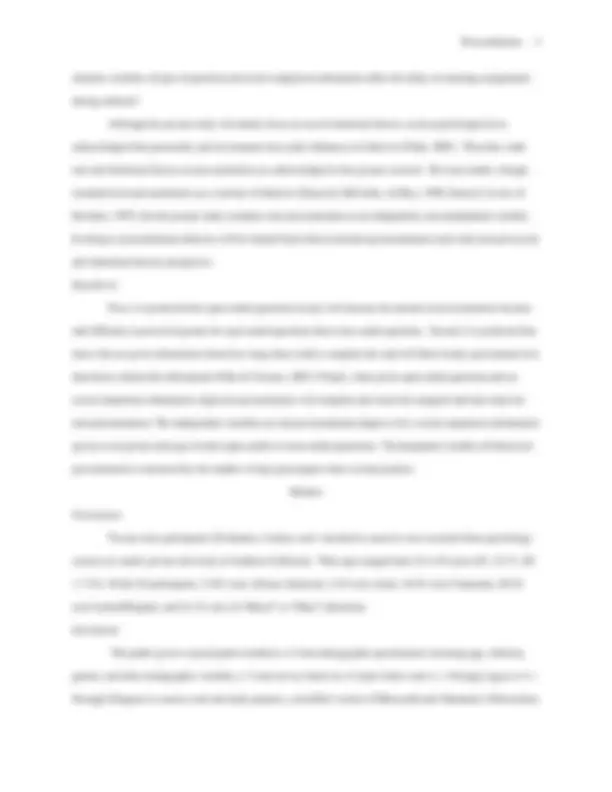
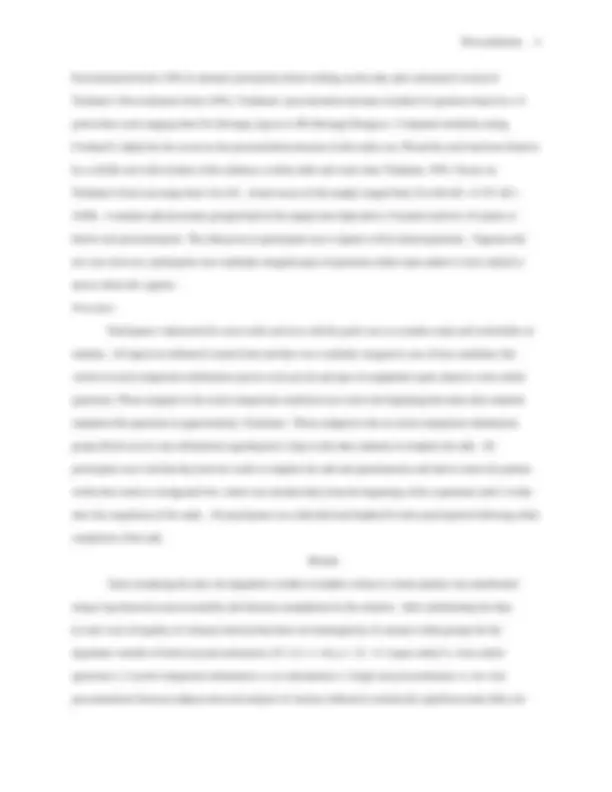
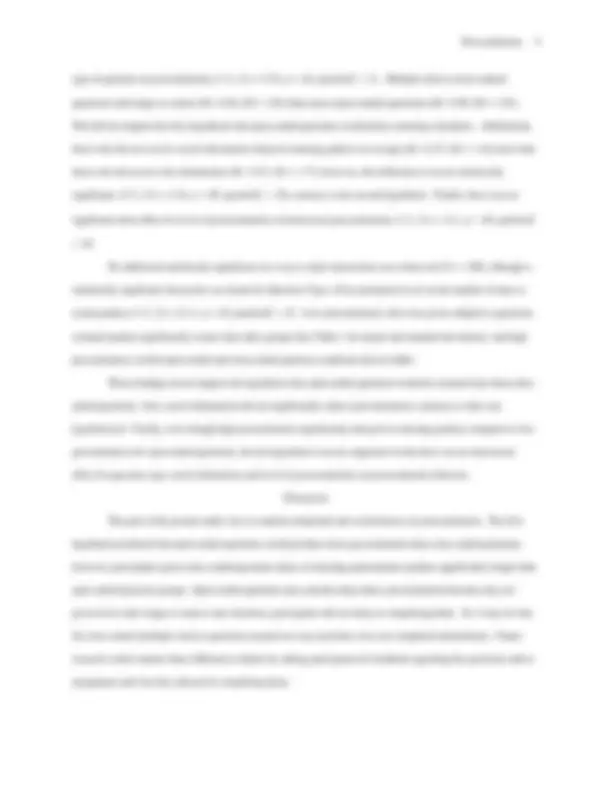
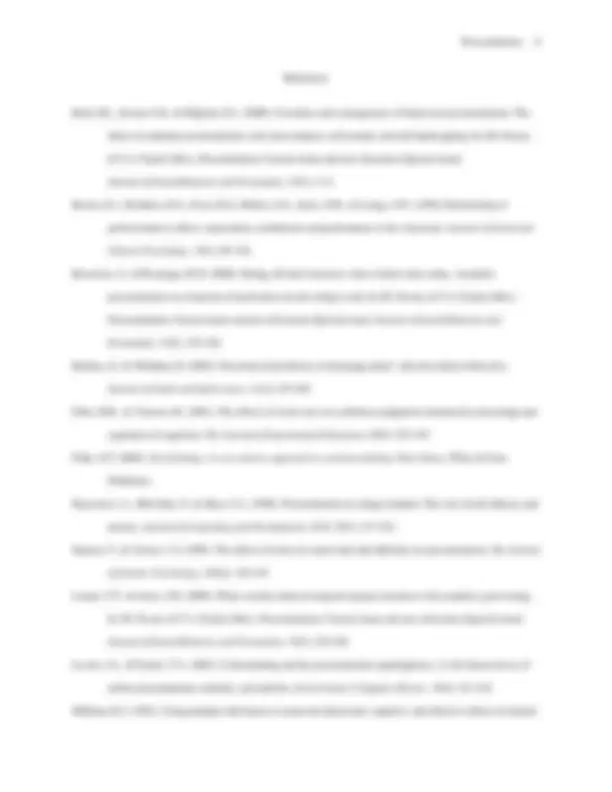
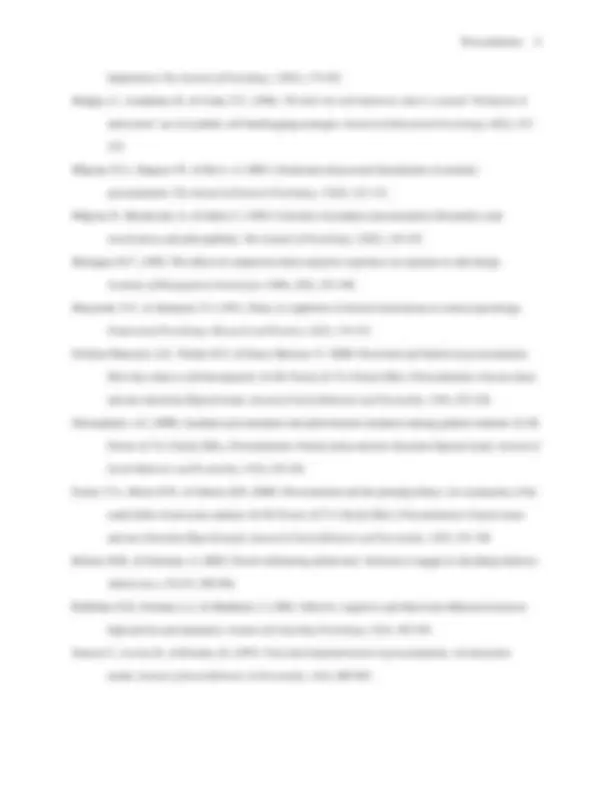
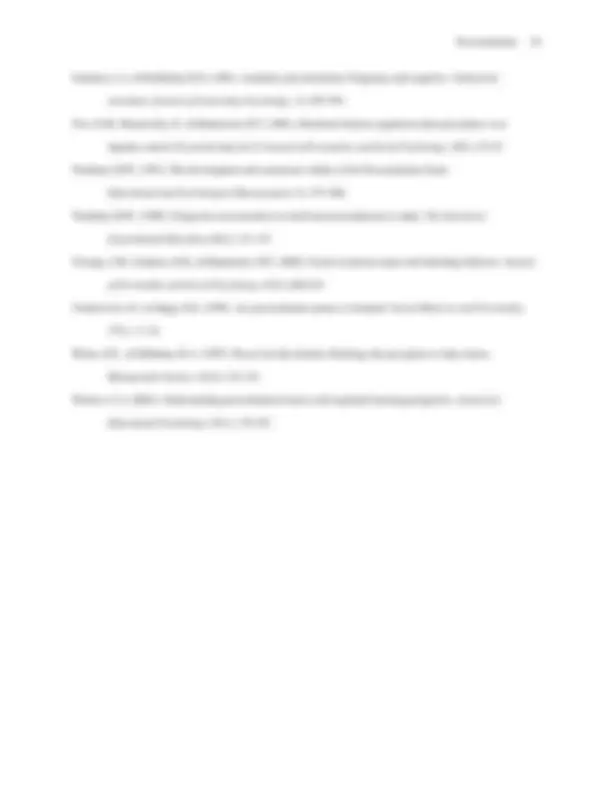


Study with the several resources on Docsity

Earn points by helping other students or get them with a premium plan


Prepare for your exams
Study with the several resources on Docsity

Earn points to download
Earn points by helping other students or get them with a premium plan
Community
Ask the community for help and clear up your study doubts
Discover the best universities in your country according to Docsity users
Free resources
Download our free guides on studying techniques, anxiety management strategies, and thesis advice from Docsity tutors
Material Type: Paper; Professor: Bui; Class: Social Psychology; Subject: Psychology; University: University of La Verne; Term: Unknown 2002;
Typology: Papers
1 / 11

This page cannot be seen from the preview
Don't miss anything!







Running head: SOCIAL AND SITUATIONAL FACTORS ON PROCRASTINATION
Social and Situational Factors on Procrastination: Type of Task and Social Information Ngoc H. Bui University of La Verne
Social and Situational Factors on Procrastination: Type of Task and Social Information Procrastination has been defined as the act of needlessly delaying a task until some point of discomfort (Solomon & Rothblum, 1984) or a form of self-defeating behavior that involves a self-destructive tendency (Twenge, Catanese, & Baumeister, 2002). Rothblum, Solomon, and Murakami (1986) found that more than 40% of the university students they sampled reported a high level of procrastination, and these participants also demonstrated behavioral delays in completing their assigned quizzes. From an educator’s perspective it is important to understand what can be done to reduce procrastination. Procrastination has been shown to be related to personality traits, such as attitudes toward learning (Midgley, Arunkumar, & Urdan, 1996), attribution styles (Brownlow & Reasinger, 2000), anxiety level (Haycock, McCarthy, & Skay, 1998), locus of control, perfectionism (Onwuegbuzie, 2000), proneness to boredom (Vodanovich & Rupp, 1999), self-efficacy (Wolters, 2003), self- esteem (Beck, Koons, & Milgrim, 2000), and self-handicapping (Midgley, Arunkumar, & Urdan, 1996). However, is there anything that educators can do to effectively reduce this dilatory behavior? Very few studies have investigated the effects of social and situational variables on procrastination behaviors among those who are low or high on trait procrastination. Social and situational variables can be controlled by instructors in the classroom; therefore, the aim of the present study is to explore how these factors may affect procrastination. Of the few studies that have investigated social and situational variables, some found that type of task and social comparison can affect procrastination. For example, Janssen and Carton (1999) investigated whether type of task assigned to students would decrease procrastination. In their study, participants were randomly assigned to complete questions related to an easy (magazine) article or difficult (research) article. Janssen and Carton found no significant differences between easy and difficult tasks, however, a limitation the researchers cited was that there may not have been a large enough difference in the level of difficulty between the two tasks (1999). Milgram. Marshevsky, and Sadeh (1994) found that task difficulty also affected the amount of procrastination in high school students. Additionally, information about how others perform on a particular task was found to affect those who did not engage in much regulation of their own cognitive processes (low cognitive regulators) (Filho & Yuzawa, 2001). Filho and Yuzawa suggest that low cognitive regulators rely on cues about how others performed in order to estimate how they will perform. Based on these previous research studies, the present study aims to examine how these two variables affect behavioral procrastination. Specifically, the question of interest is how do the social and
Procrastination Scale (1991) to measure perceptions about working on the task, and a shortened version of Tuckman’s Procrastination Scale (1991). Tuckman’s procrastination measure included 16 questions based on a 5- point Likert scale ranging from SA (Strongly Agree) to SD (Strongly Disagree). Computed reliability (using Cronbach’s alpha) for the scores on the procrastination measure in this study was .90 and the scale has been found to be a reliable and valid estimate of the tendency to delay tasks and waste time (Tuckman, 1991). Scores on Tuckman’s Scale can range from 16 to 64. Actual scores of this sample ranged from 22 to 60 ( M = 41.97, SD = 10.90). A median-split procedure grouped half of the sample into high (above 43 points) and low (43 points or below) trait procrastination. The task given to participants was a vignette with 6 related questions. Vignettes did not vary; however, participants were randomly assigned types of questions (either open-ended or close-ended) to answer about the vignette. Procedure Participants volunteered for extra credit and were told the goals were to examine study and work habits of students. All signed an informed consent form and then were randomly assigned to one of four conditions that varied on social comparison information (given or not given) and type of assignment (open-ended or close-ended questions). Those assigned to the social comparison condition were told at the beginning that most other students completed the questions in approximately 10 minutes. Those assigned to the no social comparison information group did not receive any information regarding how long it took other students to complete the task. All participants were told that they had one week to complete the task and questionnaires and had to return the packets within that week to a designated box, which was checked daily from the beginning of the experiment until 2 weeks after the completion of the study. All participants were debriefed and thanked for their participation following either completion of the task. Results Upon examining the data, the dependent variable of number of days to return packets was transformed using a log function to meet normality and linearity assumptions for the analysis. After transforming the data, Levene’s test of equality of variances showed that there was homogeneity of variance within groups for the dependent variable of behavioral procrastination, F (7, 21) = 1.46, p = .23. A 2 (open-ended vs. close-ended questions) x 2 (social comparison information vs. no information) x 2 (high trait procrastination vs. low trait procrastination) between-subjects factorial analysis of variance indicated a statistically significant main effect for
type of question on procrastination, F (1, 21) = 5.52, p < .03, partial η^2 = .21. Multiple choice (close-ended) questions took longer to return ( M = 6.56, SD = 1.04) than essay (open-ended) questions ( M = 5.09, SD = 1.92). This did not support the first hypothesis that open-ended questions would delay returning of packets. Additionally, those who did not receive social information delayed returning packets on average ( M = 6.57, SD = 1.16) more than those who did receive this information ( M = 5.47, SD = 1.77), however, this differences was not statistically significant, ( F (1, 21) = 2.42, p > .05, partial η^2 = .10), contrary to the second hypothesis. Finally, there was no
significant main effect for level of procrastination on behavioral procrastination, F (1, 21) = .411, p > .05, partial η^2 = .02. No additional statistically significant two-way or triple interactions were observed ( F s < 1.00), although a statistically significant interaction was found for Question Type x Procrastination Level on the number of days to return packets, F (1, 21) = 6.11, p = .02, partial η^2 = .23. Low procrastinators who were given subjective questions returned packets significantly sooner than other groups (See Table 1 for means and standard deviations), and high procrastinators in both open-ended and close-ended question conditions did not differ. These findings do not support the hypothesis that open-ended questions would be returned later than close- ended questions. Also, social information did not significantly reduce procrastination ,contrary to what was hypothesized. Finally, even though high procrastinators significantly delayed in returning packets compared to low procrastinators for open-ended questions, the last hypothesis was not supported in that there was no interaction effect for question type, social information and level of procrastination on procrastination behavior. Discussion The goal of the present study was to examine situational and social factors on procrastination. The first hypothesis predicted that open-ended questions would produce more procrastination than close-ended questions; however, participants given close-ended questions delay of returning questionnaire packets significantly longer than open-ended question groups. Open-ended questions may actually help reduce procrastination because they are perceived to take longer to answer and, therefore, participants did not delay in completing them. Or, it may be that the close-ended (multiple-choice) questions seemed too easy and these were not completed immediately. Future research could examine these differences further by asking participants for feedback regarding the particular task or assignment and why they delayed in completing them.
time). The findings from the present study show some indication that educators can actively create environments that could increase student productivity and efficiency, thus greatly reducing the problem of delaying completion of assignments.
References
Beck, B.L., Koons, S.R., & Milgrim, D.L. (2000). Correlates and consequences of behavioral procrastination: The effect of academic procrastination, self-consciousness, self-esteem, and self-handicapping. In J.R. Ferrari, & T.A. Pychyl (Eds.), Procrastination: Current issues and new directions [Special issue]. Journal of Social Behavior and Personality, 15 (5), 3-13. Brown, E.J., Heimbert, R.G., Frost, R.O., Makris, G.S., Juster, H.R., & Leung, A.W. (1999). Relationship of perfectionism to affect, expectations, attributions and performance in the classroom. Journal of Social and Clinical Psychology, 18 (1), 98-120. Brownlow, S., & Reasinger, R.D. (2000). Putting off until tomorrow what is better done today: Academic procrastination as a function of motivation toward college work. In J.R. Ferrari, & T.A. Pychyl (Eds.), Procrastination: Current issues and new directions [Special issue]. Journal of Social Behavior and Personality, 15 (5), 225-238. Bradley, G., & Wildman, K. (2002). Psychosocial predictors of emerging adults’ risk and reckless behaviors. Journal of Youth and Adolescence, 31 (4), 253-265. Filho, M.K., & Yuzawa, M. (2001). The effects of social cues on confidence judgments mediated by knowledge and regulation of cognition. The Journal of Experimental Education, 69 (4), 325-343. Fiske, S.T. (2004). Social beings: A core motives approach to social psychology. New Jersey: Wiley & Sons Publishers. Haycock, L.A., McCarthy, P., & Skay, C.L. (1998). Procrastination in college students: The role of self-efficacy and anxiety. Journal of Counseling and Development: JCD, 76 (3), 317-324. Janssen, T., & Carton, J. S. (1999). The effects of locus of control and task difficulty on procrastination. The Journal of Genetic Psychology, 160 (4), 436-442. Lasane, T.P., & Jones, J.M. (2000). When socially induced temporal myopia interferes with academic goal-setting. In J.R. Ferrari, & T.A. Pychyl (Eds.), Procrastination: Current issues and new directions [Special issue]. Journal of Social Behavior and Personality, 15 (5), 225-238. Lavoie, J.A., & Pychyl, T.A. (2001). Cyberslacking and the procrastination superhighway: A web-based survey of online procrastination, attitudes, and emotion. Social Science Computer Review, 19 (4), 431-444. McKean, K.J. (1994). Using multiple risk factors to assess the behavioral, cognitive, and affective effects of learned
Solomon, L.J., & Rothblum, E.D. (1984). Academic procrastination: Frequency and cognitive –behavioral correlates. Journal of Counseling Psychology, 33 , 387-394. Tice, D.M., Bratslavsky, E., & Baumeister, R.F. (2001). Emotional distress regulation takes precedence over impulse control: If you feel bad, do it! Journal of Personality and Social Psychology , 80 (1), 53-67. Tuckman, B.W. (1991). The development and concurrent validity of the Procrastination Scale. Educational and Psychological Measurement, 51, 473-480. Tuckman, B.W. (1998). Using tests as an incentive to motivate procrastinators to study. The Journal of Experimental Education , 66 (2), 141-147. Twenge, J.M., Catanese, K.R., & Baumeister, R.F. (2002). Social exclusion causes self-defeating behavior. Journal of Personality and Social Psychology, 83 (3), 606-615. Vodanovich, S.J., & Rupp, D.E. (1999). Are procrastinators prone to boredom? Social Behavior and Personality, 27 (1), 11-16. Weber, E.U., & Milliman, R.A. (1997). Perceived risk attitudes: Relating risk perception to risky choice. Management Science, 43 (2), 123-144. Wolters, C.A. (2003). Understanding procrastination from a self-regulated learning perspective. Journal of Educational Psychology, 95 (1), 179-187.
Table 1 Means and Standard Deviations of Level of Procrastination and Question Type on Number of Days to Complete Task
High Procrastination Level Low Procrastination Level
M SD n M SD n Objective Questions 6.29 1.11 7 6.72 1.01 11 Subjective Questions 6.14 1.21 7 3.25 1.50 4